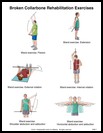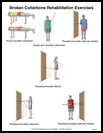
Broken Collarbone Exercises
- Wand exercise, Flexion: Stand upright and hold a stick in both hands, palms down. Stretch your arms by lifting them over your head, keeping your arms straight. Hold for 5 seconds and return to the starting position. Repeat 10 times.
- Wand exercise, Extension: Stand upright and hold a stick in both hands behind your back. Move the stick away from your back. Hold the end position for 5 seconds. Relax and return to the starting position. Repeat 10 times.
- Wand exercise, External rotation: Lie on your back and hold a stick in both hands, palms up. Your upper arms should be resting on the floor with your elbows at your sides and bent 90 degrees. Use your uninjured arm to push your injured arm out away from your body. Keep the elbow of your injured arm at your side while it is being pushed. Hold the stretch for 5 seconds. Repeat 10 times.
- Wand exercise, Internal rotation: Stand with your uninjured arm behind your head holding the end of a stick. Put your injured arm behind your back at your waist and grab the stick. Pull the stick up behind your back by straightening the elbow of your uninjured arm and bending the elbow of your injured arm. Hold this position for 5 seconds and then go back to the starting position. Repeat 10 times.
- Wand exercise, Shoulder abduction and adduction: Stand and hold a stick with both hands, palms facing away from your body. Rest the stick against the front of your thighs. Use your uninjured arm to push your injured arm out to the side and up as high as possible. Keep your arms straight. Hold for 5 seconds. Repeat 10 times.
- Wand exercise, Horizontal abduction and adduction: Stand and hold a stick in both hands. Stretch your arms straight out in front of you at shoulder height. Keeping your arms straight, swing the stick to one side. Feel the stretch and hold for 5 seconds. Then swing the stick to the other side, feel the stretch, and hold for 5 seconds. Repeat 10 times.
- Shoulder flexion: Stand with your arms hanging down at your sides. Keep your arms straight and lift them in front of you and up over your head as far as you can reach. Hold this position for 5 seconds and then bring your arms back down in front of you and to your sides. Do 2 sets of 15.
- Shoulder abduction: Stand with your arms at your sides. Bring your arms up, out to the side, and toward the ceiling. Hold for 5 seconds. Return to the starting position. Repeat 10 times.
- Horizontal shoulder abduction: Stand with your arms held straight out in front of you at shoulder height. Pull your arms apart and out to the sides as far as possible. Hold your arms back for 5 seconds, then bring them back together in front of you. Repeat 10 times. Remember to keep your arms at shoulder height throughout the exercise.
- Shoulder extension: Stand with your arms at your sides. Move the arm on your injured side back, keeping the arm straight. Hold this position for 5 seconds. Return to the starting position and repeat 10 times.
- Scapular active range of motion: Stand and shrug your shoulders up and hold for 5 seconds. Then squeeze your shoulder blades back and together and hold 5 seconds. Next, pull your shoulder blades downward as if putting them in your back pocket. Relax. Repeat this sequence 10 times.
- Side-lying horizontal abduction: Lie on your uninjured side with the arm on your injured side relaxed across your chest. Slowly bring this arm up off the floor so that your hand is pointing toward the ceiling. Keep your arm straight as you do this. Do 2 sets of 15. Hold a weight in your hand as the exercise becomes easier.
- Prone shoulder extension: Lie on your stomach on a table or the edge of a bed with the arm on your injured side hanging down over the edge. Slowly lift your arm straight back and toward the ceiling. Do not bend your elbow. Return to the starting position. Do 2 sets of 15. As this becomes easier, hold a weight in your hand.
- Single-arm shoulder abduction: Stand with your arms at your sides, your palms resting against your sides. Lift the arm on your injured side out to the side and toward the ceiling. Keep your arm straight. Hold the position for 5 seconds and then bring your arm back to your side. Repeat 10 times. Add a weight to your hand as this exercise becomes easier.
- Resisted shoulder internal rotation: Stand sideways next to a door with your injured arm closest to the door. Tie a knot in the end of the tubing and shut the knot in the door at waist level. Hold the other end of the tubing with the hand of your injured arm. Bend the elbow of your injured arm 90 degrees. Keeping your elbow in at your side, rotate your forearm across your body and then back to the starting position. Make sure you keep your forearm parallel to the floor. Do 2 sets of 15.
- Resisted shoulder flexion: Holding tubing connected to a door knob at waist level, face away from the door, keep your elbow straight and pull your arm forward. Do 2 sets of 15.
- Resisted shoulder extension: Stand facing a door. Tie a knot in the end of the tubing and shut the knot in the door at shoulder height. Use the hand on your injured side to hold the tubing at shoulder height. Pull your arm back, keeping your arm straight. Do 2 sets of 15.
- Resisted shoulder external rotation: Stand sideways next to a door with your injured arm farther from the door. Tie a knot in the end of the tubing and shut the knot in the door at waist level. Hold the other end of the tubing with the hand of your injured arm. Rest the hand of your injured arm across your stomach. Keeping your elbow in at your side, rotate your arm outward and away from your waist. Make sure you keep your elbow bent 90 degrees and your forearm parallel to the floor. Repeat 10 times. Build up to 2 sets of 15.
Written by Tammy White, MS, PT, and Phyllis Clapis, PT, DHSc, OCS, for RelayHealth.
This content is reviewed periodically and is subject to change as new health information becomes available. The information is intended to inform and educate and is not a replacement for medical evaluation, advice, diagnosis or treatment by a healthcare professional.
© 2011 RelayHealth and/or its affiliates. All rights reserved.



